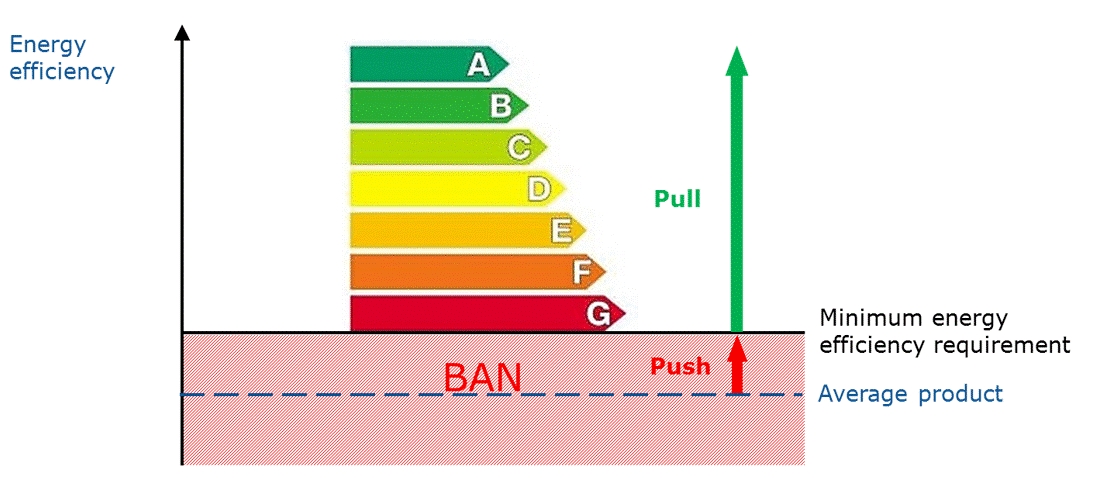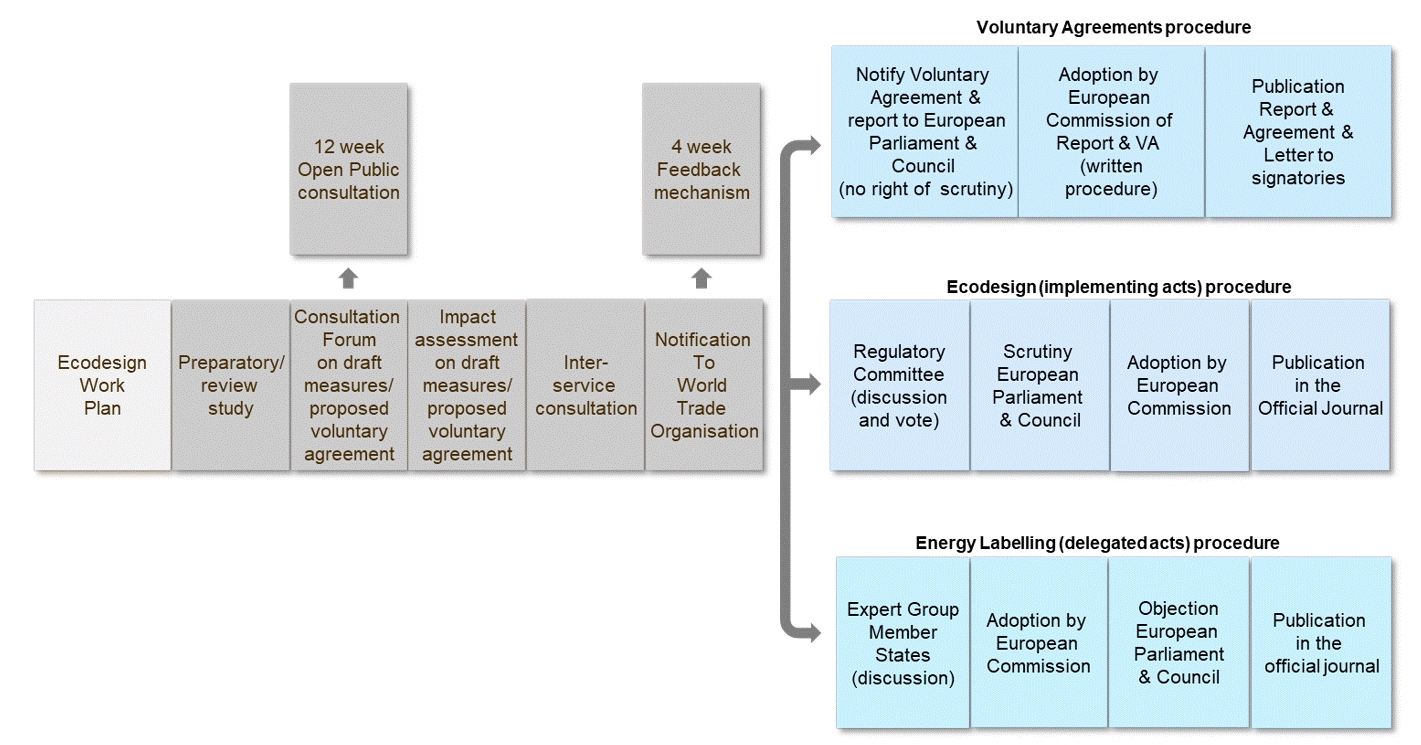The new ecodesign measures explained
- What has the Commission adopted today?
Today, the Commission adopted 10 ecodesign implementing regulations, setting out energy efficiency and other requirements for the following product groups:
- Refrigerators
- Washing machines
- Dishwashers
- Electronic displays (including televisions)
- Light sources and separate control gears
- External power suppliers
- Electric motors
- Refrigerators with a direct sales function (e.g. fridges in supermarkets, vending machines for cold drinks)
- Power transformers
- Welding equipment
Eight of these regulations revise already existing requirements, whereas refrigerators with a direct sales function and welding equipment are regulated for the first time.
- What are the overall benefits of the Ecodesign and Energy Labelling Package?
The European Commission estimates that this package of measures will deliver 167 TWh of final energy savings per year by 2030. This is equivalent to the annual energy consumption of Denmark.
These savings correspond to a reduction of over 46.million tonnes of CO2 equivalent.
More importantly, through these measures European households save on average 150 EUR per year.
These savings come on top of the savings achieved by the existing ecodesign measures and energy labels.
- How are these measures linked with the new EU energy labels?
Six of the product groups that are subject to new and revised ecodesign requirements, are also covered by new energy labelling rules, i.e. Refrigerators, Washing machines, Dishwashers, Electronic displays (including televisions), Light sources and Refrigerators with a direct sales function.
In particular for consumer products, ecodesign and energy labelling go hand in hand providing European consumers with valuable information and thereby enabling them to make an informed choice and eventually drive the market towards more energy efficient products.
- How do these measures help contribute to the circular economy and the protection of the environment?
The Ecodesign Working Plan 2016-2019 identified the potential of ecodesign measures to contribute significantly to circular economy objectives. Preparatory and review studies for product specific measures now systematically consider resource efficiency aspects.
Decisions made at the design phase greatly influence what happens during the use and end-of-life phases, not only in terms of energy consumption, but also in terms of life span, maintenance, repair, reuse, upgrade, recyclability and waste handling.
These measures also bring benefits at macroeconomic level, by reducing Europe’s energy bill through energy savings and by reducing greenhouse gas emissions. In this way, they represent a direct contribution to the implementation of the Paris Agreement.
This set of ecodesign measures is a concrete contribution to our circular economy and climate objectives. In particular, measures are included for the first time under ecodesign to support the reparability and recyclability of products. Moreover, existing requirements on durability (for lighting), water consumption (for dishwashers and washing machines) and marking of chemicals were also revised and adapted as appropriate.
- What improvements have been proposed on reparability and durability of appliances?
In order to promote reparability, and therefore to increase the lifespan of appliances, several ecodesign measures aim at facilitating products repair by ensuring the availability of spare parts, in particular that:
- spare parts are available over a long period of time after purchase, e.g.:
o 7 years minimum for refrigerating appliances (10 years for door gaskets);
o 10 years minimum for household washing-machines and household washer-dryers;
o 10 years minimum for household dishwashers (7 years for some parts for which access can be restricted to professional repairers);
o moreover, during that period, the manufacturer shall ensure the delivery of the spare parts within 15 working days.
- spare parts can be replaced with the use of commonly available tools and without permanent damage to the appliance;
In order to enhance the repair market, manufacturers have to ensure the availability of repair and professional maintenance information for professional repairers.
- What improvements have been proposed on better water use?
Ecodesign measures for washing machines, washer-dryers, and dishwashers set a maximum use of water per cycle.
At the same time, a minimum of washing efficiency and rinsing effectiveness are required so that the reduction of water use is not achieved to the detriment of washing and rinsing performance.
For household washing machines and household washer-dryers, the impact assessment of the new measures estimates that 711 million m3/year water savings can be achieved by 2030. As for dishwashers, water savings should amount to 16 million m3/year by 2030.
- Are other non–EU countries adopting these ecodesign measures?
No. EU ecodesign measures only apply to products placed on the Union market, independently of where they are manufactured. However, many other countries look to the European Union for inspiration when developing their own policies in this area.
- What is the legislative framework in place for ecodesign and energy labelling?
In the EU, the Ecodesign Framework Directive sets a framework requiring manufacturers of energy-related products to improve the environmental performance of their products.
The Energy Labelling Framework Regulation complements the ecodesign framework directive by enabling end-consumers to identify the better-performing energy-related products.
The energy label is recognised by 93% of Europeans and 79% have been influenced by it when buying an appliance, according to a recent Eurobarometer survey.
The legislative framework builds upon the combined effect of the two aforementioned pieces of legislation.

Figure 1: Synergetic effect Ecodesign and energy labelling
The ecodesign framework directive and the energy labelling framework regulationare implemented through product-specific implementing and delegated regulations.
As an alternative to the mandatory ecodesign requirements, voluntary agreements or other self-regulation measures can be presented by the industry (see also article 17 of the ecodesign framework directive). If certain criteria are met the Commission formally recognises these voluntary agreements.
- How are decisions on ecodesign measures taken?
First, priority product groups are selected based on their potential for cost-effective reduction of greenhouse gas emissions and following a fully transparent process culminating in working plans that outline the priorities for the development of implementing measures.
Secondly, a preparatory study, involving extensive technical discussions with interested stakeholders, is undertaken by an independent consultant.
Thirdly, the Commission’s first drafts of ecodesign and energy labelling measures are submitted for discussion to the Consultation Forum, consisting of Member States’ and other stakeholders’ representatives.
Hereafter, the Commission publishes draft implementing measures.in the WTO notification database.
Once this phase is completed, the two procedures follow different paths. The draft energy labelling delegated acts are discussed in a Member State expert group where opinion(s) are expressed and consensus is sought but no vote is taken. The draft ecodesign measures are submitted for vote to the regulatory committee.
The European Parliament and Council have the right of scrutiny for a period of up to four months is foreseen. If no objection is received, the measures are published in the Official Journal and enter into force.
